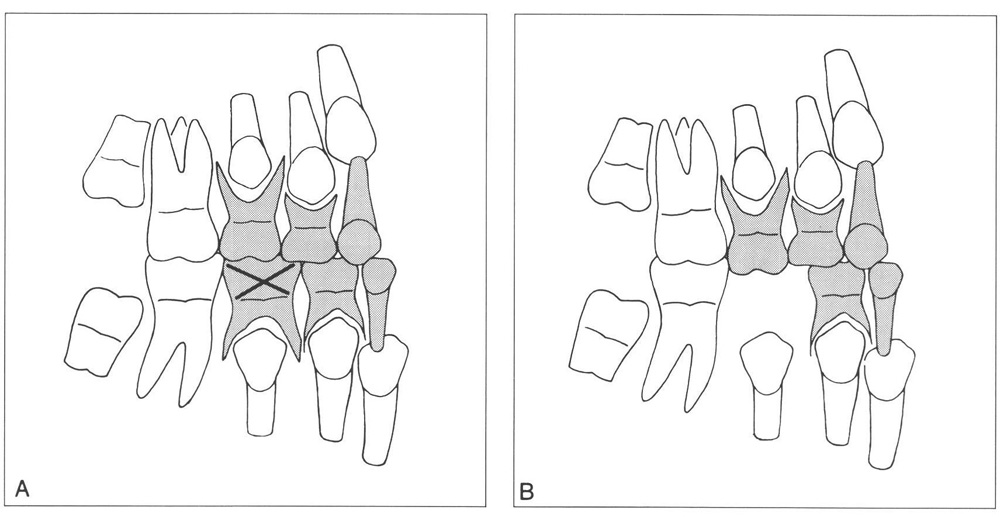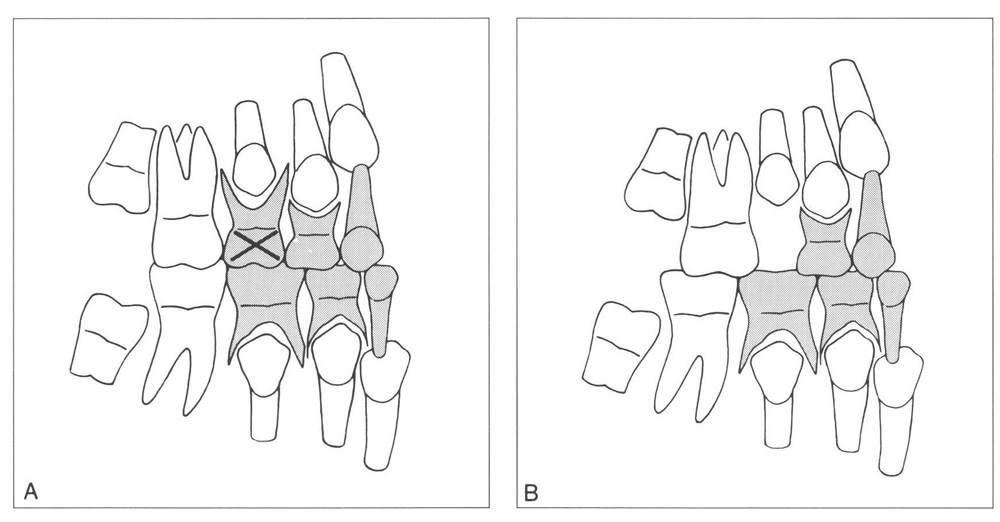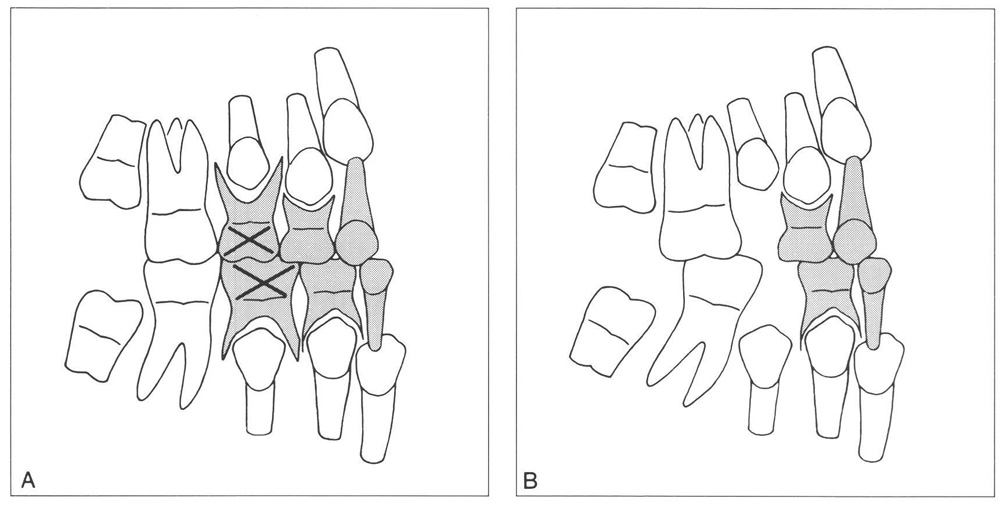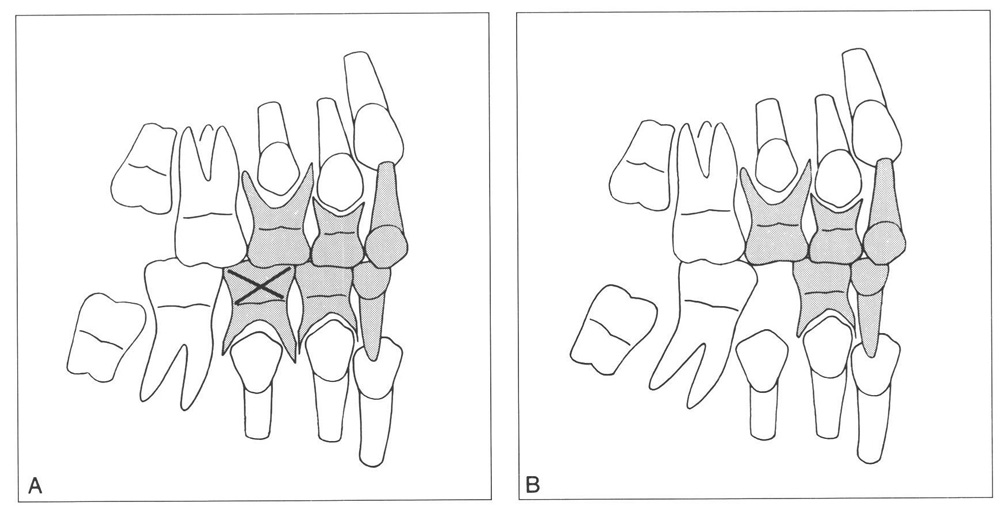Premature Loss of Deciduous Molars
Deciduous molars can lose all or part of their crowns as the result of caries. Because of pain, the remains of the tooth and roots are often extracted. It can also happen that pulp infection earlier in the course of caries gives rise to inflammatory phenomena that may be dealt with by extraction. Premature loss is found twice as often in the mandible as in the maxilla.27, 84, 151, 215
One of the consequences of premature loss can be the migration of adjacent teeth into the space vacated, with the result that the successor to the lost deciduous tooth finds the space intended for it is already partly or fully occupied. This does not by any means always occur. In the majority of cases premature loss has no permanent deleterious effect on the further development and disposition of the permanent dentition.
The results of premature loss of deciduous teeth depend on a number of factors. The following aspects will be dealt with successively: space conditions in the dental arches, occlusion after loss of second deciduous molars, loss of first deciduous molars, stage of development of the dentition at the time of loss, influence of the lips and tongue, effect on the anterior occlusion, regaining lost space, and indications for space maintainers.
14.2 Space conditions in the dental arch
In general, it can be said that in dental arches with excess space the premature loss of deciduous teeth has a negligible effect, if any, on the future development and ultimate arrangement of the permanent teeth. On the other hand, in situations where there is no excess space in the arches, complications in the further development can indeed follow. Premature loss of deciduous teeth in arches with crowding almost always has marked, unfavourable, results. The crowding will, as a rule, increase noticeably.
The space conditions are more favourable in the mandible than in the maxilla, partly because in the mandible the difference between the sum of the mesiodistal crown diameters of the first and second deciduous molars and those of their successors is greater than in the maxilla. A larger amount of space can be lost before it becomes a problem. This applies especially in those situations where much space is available for teeth in the mandibular arch as a whole.
14.3 Occlusion after loss of second deciduous molars
The sagittal occlusion of the individual teeth plays a large part in the effects that result from premature loss of deciduous molars. Overeruption of antagonists can block movement along the arch and may prevent it altogether.
Whether or not an opposing deciduous molar will overerupt after premature loss depends on the occlusion, size of the relevant deciduous molar in relation to the extraction space, and influence of the tongue.
The significance of the occlusion as it affects the results of premature loss of second deciduous molars in both jaws in neutro-, disto-, and mesio-occlusion will be clarified and illustrated. Particularly relevant in this respect is the fact that the mandibular second deciduous molar often has a notably greater mesiodistal crown diameter than the one from the maxilla.
In neutro-occlusion there is usually a flush terminal plane. In these circumstances a maxillary deciduous second molar can overerupt after loss of its antagonist, and by doing so would obstruct the mesial migration of the mandibular first permanent molar (Fig. 14-1). The occlusal relationships determine to what degree migration will occur. More migration will take place in cases of a flush terminal than in those of a mesial step.

Fig. 14-1 Premature loss of the mandibular second deciduous molar; neutro-occlusion.
A The mandibular second deciduous molar has a larger mesiodistal crown diameter than the maxillary second deciduous molar. The terminal plane of the deciduous dentition has only a small mesial step.
B The maxillary second deciduous molar can overerupt and thereby obstruct the mesial migration of the mandibular first permanent molar. Further development of the dentition shows no deleterious consequences from the premature loss.
When the maxillary second deciduous molar is prematurely lost, the mandibular second deciduous molar will not overerupt because it still has an antagonist: the maxillary first deciduous molar (Fig. 14-2). The maxillary first permanent molar can therefore migrate mesially. However, it does not move bodily but rotates around the axis through the mesiopalatal cusp and the palatal root. The cusp occludes in the central fossa of the mandibular first permanent molar, while the palatal root is the principal, most substantial root of the maxillary first permanent molar.

Fig. 14-2 Premature loss of the maxillary second deciduous molar; neutro-occlusion.
A The mandibular second deciduous molar has a broader crown than its antagonist. As a result it occludes with two teeth and when the maxillary second molar is lost, the mandibular molar is still in occlusion with the first deciduous molar in the maxilla.
B The maxillary first permanent molar migrates mesially, and in so doing it rotates around an axis through the mesiopalatal cusp and the palatal root. Consequently, it takes up more room in the dental arch, because the crown has a rhomboid cross section.
Loss of the mandibular and the maxillary second deciduous molars on the same side nearly always has an unfortunate effect on further development of the dentition (Fig. 14-3). Mesial migration of the mandibular first permanent molar is no longer inhibited by an overerupted maxillary second deciduous molar. The maxillary molar drifts further than it would have done if the premature loss had been only in the maxillary arch. The occlusion of the mesiopalatal cusp in the central fossa of the mandibular first permanent molar now offers no resistance to mesial migration, because the mandibular molar also moves mesially.

Fig. 14-3 Unilateral premature loss of mandibular and maxillary second deciduous molars; neutro-occlusion.
A After loss of both second deciduous molars there is no obstruction by overeruption of the maxillary second deciduous molar to prevent mesial drift of the mandibular first permanent molar.
B The first permanent molars in both jaws migrate mesially. The maxillary molar does that to a greater degree than it would have if the premature loss had occurred only in the maxilla. The movement of the mandibular first permanent molar frequently takes place in association with a certain degree of mesiolingual rotation. Mesial migration of the first permanent molars after premature loss of deciduous molars can be followed by accelerated eruption and early emergence of the second permanent molars.
In a case of disto-occlusion it is possible, after premature loss of a mandibular second deciduous molar, that the maxillary deciduous second molar will not overerupt because it still occludes with the mandibular first deciduous molar. The mandibular first permanent molar experiences no restraint from the maxillary second deciduous molar in its tendency to migrate mesially (Fig. 14-4).

Fig. 14-4 Premature loss of the mandibular second deciduous molar; disto-occlusion.
A The maxillary second deciduous molar occludes not only with the corresponding mandibular one but also with the deciduous first molar.
B Because the maxillary second deciduous molar is unable to overerupt, the mesial migration of the mandibular first permanent molar will not be obstructed. If the lower lip is interposed between the maxillary and mandibular incisors, the existing space in the arch will be lost more from the mesial aspect than would otherwise be the case.
After loss of a maxillary second deciduous molar, mesial migration and rotation of the maxillary first permanent molar will occur in a case of disto-occlusion comparable to that described for neutro-occlusion (Fig. 14-5).

Fig. 14-5 Premature loss of the maxillary second deciduous molar; disto-occlusion.
A The broader mandibular deciduous molar here also is unable to overerupt after loss of its antagonist.
B The maxillary first permanent molar drifts mesially. Its mesiopalatal cusp does not occlude into the central fossa of the mandibular first permanent molar, so that the opposition to mesial migration usually offered by the occlusal interdigitation is reduced.
Should the second deciduous molars be lost in both jaws on one side in disto-occlusion, the first permanent molars in both jaws will migrate mesially (Fig. 14-6). In the mandible this usually is more marked, principally as the result of the greater difference in mesiodistal crown diameters between the teeth that have been lost and those that succeed them.
Stay updated, free dental videos. Join our Telegram channel

VIDEdental - Online dental courses


